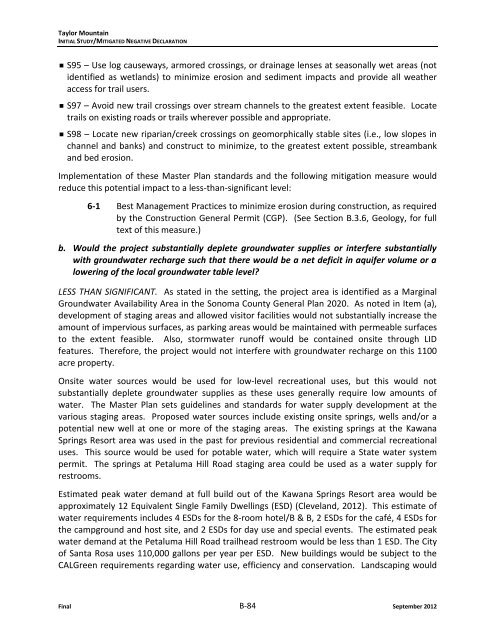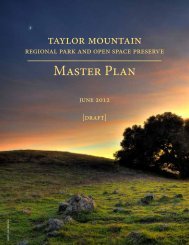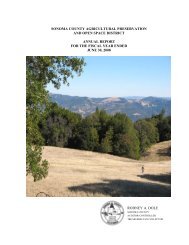Initial Study MND - Sonoma County Agricultural Preservation and ...
Initial Study MND - Sonoma County Agricultural Preservation and ...
Initial Study MND - Sonoma County Agricultural Preservation and ...
You also want an ePaper? Increase the reach of your titles
YUMPU automatically turns print PDFs into web optimized ePapers that Google loves.
Taylor MountainINITIAL STUDY/MITIGATED NEGATIVE DECLARATION S95 – Use log causeways, armored crossings, or drainage lenses at seasonally wet areas (notidentified as wetl<strong>and</strong>s) to minimize erosion <strong>and</strong> sediment impacts <strong>and</strong> provide all weatheraccess for trail users. S97 – Avoid new trail crossings over stream channels to the greatest extent feasible. Locatetrails on existing roads or trails wherever possible <strong>and</strong> appropriate. S98 – Locate new riparian/creek crossings on geomorphically stable sites (i.e., low slopes inchannel <strong>and</strong> banks) <strong>and</strong> construct to minimize, to the greatest extent possible, streambank<strong>and</strong> bed erosion.Implementation of these Master Plan st<strong>and</strong>ards <strong>and</strong> the following mitigation measure wouldreduce this potential impact to a less-than-significant level:6-1 Best Management Practices to minimize erosion during construction, as requiredby the Construction General Permit (CGP). (See Section B.3.6, Geology, for fulltext of this measure.)b. Would the project substantially deplete groundwater supplies or interfere substantiallywith groundwater recharge such that there would be a net deficit in aquifer volume or alowering of the local groundwater table level?LESS THAN SIGNIFICANT. As stated in the setting, the project area is identified as a MarginalGroundwater Availability Area in the <strong>Sonoma</strong> <strong>County</strong> General Plan 2020. As noted in Item (a),development of staging areas <strong>and</strong> allowed visitor facilities would not substantially increase theamount of impervious surfaces, as parking areas would be maintained with permeable surfacesto the extent feasible. Also, stormwater runoff would be contained onsite through LIDfeatures. Therefore, the project would not interfere with groundwater recharge on this 1100acre property.Onsite water sources would be used for low-level recreational uses, but this would notsubstantially deplete groundwater supplies as these uses generally require low amounts ofwater. The Master Plan sets guidelines <strong>and</strong> st<strong>and</strong>ards for water supply development at thevarious staging areas. Proposed water sources include existing onsite springs, wells <strong>and</strong>/or apotential new well at one or more of the staging areas. The existing springs at the KawanaSprings Resort area was used in the past for previous residential <strong>and</strong> commercial recreationaluses. This source would be used for potable water, which will require a State water systempermit. The springs at Petaluma Hill Road staging area could be used as a water supply forrestrooms.Estimated peak water dem<strong>and</strong> at full build out of the Kawana Springs Resort area would beapproximately 12 Equivalent Single Family Dwellings (ESD) (Clevel<strong>and</strong>, 2012). This estimate ofwater requirements includes 4 ESDs for the 8-room hotel/B & B, 2 ESDs for the café, 4 ESDs forthe campground <strong>and</strong> host site, <strong>and</strong> 2 ESDs for day use <strong>and</strong> special events. The estimated peakwater dem<strong>and</strong> at the Petaluma Hill Road trailhead restroom would be less than 1 ESD. The Cityof Santa Rosa uses 110,000 gallons per year per ESD. New buildings would be subject to theCALGreen requirements regarding water use, efficiency <strong>and</strong> conservation. L<strong>and</strong>scaping wouldFinal B-84 September 2012







